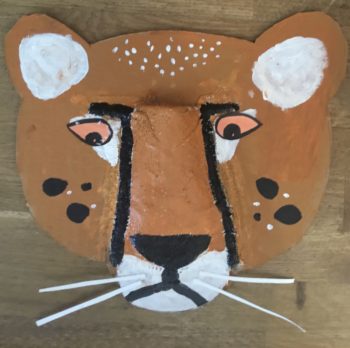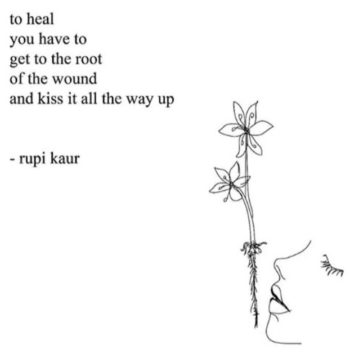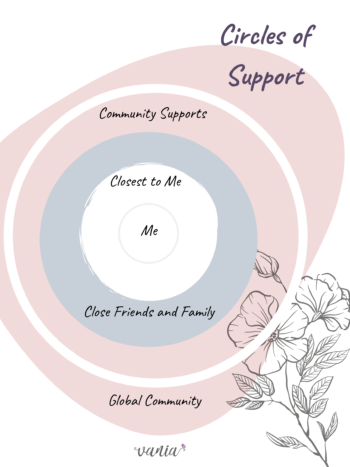I’m a big fan of tigers, jaguars and panthers. I love how they live in a pack, are caring for the little ones, and are so tough. And yet they are used a lot as reference to the things our bodies fear the most. Have you heard the expression “your body is afraid of the tiger in the bushes?” We either flee them, play dead, or try to fight back. In today’s current global crisis, Covid has become that tiger. Our body prepares to keep us safe by bringing up times we were in harm’s way, similar to an alarm system. Our ancestors surely faced more dangerous tigers, and we still embody this primitive, reptilian reaction in our present life. 
I’ve spent my career supporting others who are healing from trauma, both relational or developmental trauma as well as birth trauma. I’d like to think I know a few things about how to help others heal. In fact, I am so passionate about helping people heal from their past trauma and believe that they can. I have gone through my own experiences of trauma and pain. And yet, I have never gone through a pre-traumatic event with any of my clients or community.
None of us have.
This pandemic is the first collective trauma of this kind any of us in this lifetime has endured. Of course, some of us have endured other forms of trauma including relational abuse and war. Some of have faced institutional oppression, racism, and genocide. Some of us have ancestors who experienced violence and trauma and still are impacted by it – as well as us as our bodies have inherited that lived experience of trauma. In today’s pandemic, we may not be impacted by it in the same way, and yet we are all experiencing some level of pain from this global health crisis.
Our body and brain are experiencing some levels of stress. Some of us still have to leave their homes to work and that is anxiety-inducing. Some of us have family members who need to leave home to work and that is nerve-wracking. Others of us have to stay at home with someone who is abusive towards them, and they are in a constant state of activation. Others have lost income due to jobs that are no longer there, or have family who has been diagnosed with Covid19.
The current collective trauma is a re-traumatizing experience for those that experienced trauma in the past. Being stuck indoors reactivates the body’s reminder that it cannot leave and needs to flee in order to be safe. Some clients have shared with me that their former trauma is really resurfacing for them as their body recalls similar sensations as in the past trauma experience. Their bodies feel stuck, they can’t release their feelings, or feel like they are walking on eggshells in order to not cause a volcano explosion – their partners, theirs, or their children’s. A lot of us are just within or outside our Window of Tolerance of regulation.
We do not have to be trauma survivors to experience fear and trauma during this crisis. Double trauma is the new experience mixed with old ones, and peritrauma is the potential of becoming traumatized during this event. After all, trauma is defined as something too big, too much and too fast to bear. I know I am experiencing a lot right now that is too much and too fast to digest.
Trauma is an embodied felt sense after experiencing something hard we are not able to rebound from. Trauma lives in our body as well as mind so we need strategies that help both parts heal. This helps us move past a startle defense response that keeps trauma active in the body.
 We are now past the initial “Honeymoon stage” of life temporarily in Quarantine and Distancing. Some of us have found some ways to imbed a new routine and others are feeling more activated by the ongoing pandemic and its impact on our everyday lives. We have the potential to bounce back after this experience, but the uncertainty of when it ends keeps us feeling stuck.
We are now past the initial “Honeymoon stage” of life temporarily in Quarantine and Distancing. Some of us have found some ways to imbed a new routine and others are feeling more activated by the ongoing pandemic and its impact on our everyday lives. We have the potential to bounce back after this experience, but the uncertainty of when it ends keeps us feeling stuck.
Our brain’s Central Nervous System is made up of 2 parts – the Sympathetic Nervous System (SNS) and Parasympathetic Nervous System (PNS). Our sympathetic nervous system helps us prepare for things and keeps us protected. You many have heard of the term “Fight or Flight” as reference to our body’s way of reacting to feeling unsafe and needing to either flee the tiger or fight off the tiger. Two more ‘f Words’ are Freeze and Fawn, which are at the other end of our brain’s way of responding to threat to safety. Each are an innate instinctual response to threat, as our body’s alarm system is activated to respond in a pre-determined way. We can’t typically change how we respond but we can lessen the impact and severity.
An embodied sense of trauma is not so much about what happened to us as how it lingers in our body, so we don’t need to talk about the event itself. Rather, what we need is having empathic listening, resources, and rest. We have an innate capacity to move through trauma, it just needs to be supported. It helps to have someone bear witness to us so that we don’t hold inside the trauma in absence of a compassionate witness. In my previous post, I shared ways to build this community so you feel less alone in your experience.
Trauma processing work doesn’t erase the trauma but rather minimizes how it grabs us. A main goal of therapy is to uncouple trauma-based emotions from the sensation that is stored in your body. This will then help you integrate the impact in your body as a memory rather than a real-life reminder in the here and now.
You can definitely do things in the here and now to lessen the impact of peri-trauma in your body. While therapy is a key support, it is not alone in ways to help yourself.
Things to do for you now “Without tools trauma rules”
We build resilience as we build our capacity to take care of ourselves after trauma. It may help to notice what your response is. Do you have a sense of this already? If not, this article may help a lot as it may be beneficial to sit with your thoughts as you reflect on times in your life where you reacted to something that upset you. Try not to think of something too big as it may make you re-live it, but rather a time when you were surprised and how your body responded.
For instance, I am a Freezer. I freeze when I am scared. My body feels stuck in place and my feet feel like they are frozen in ice. And not like Elsa. Let me share this story to paint the picture a bit better: my son fell down the stairs once when he was not even 2 years old. As he inched closer to the stairs, I noticed my alarm system react. But I felt stuck in ice or quicksand and could not move to rescue him. I screamed and responded to him when he was already at the bottom of the stairs. He was fine, and only bit his lip. Now, whenever he or his sister is at the top of any staircase, I recall this sensation in my body.
My son is a Fighter – even the lightest tickle will turn my son into a green mini-Hulk. He cannot bear the sensation, even if by accident and he will hit with fists to protect himself. My daughter is a Fawn who seeks closeness to us when scared, and also is more quick to bounce back and people please after a conflict.
Once you get a sense of the reaction in your own body, it makes it easier to know the tools, resources and exercises that help you in the here and now moment of your SNS kicking in. Here are some tips to help you when your Alarm system (aka SNS) is on and you can’t access the parasympathetic part of social connection or rest. Accessing these resources may help you get back into regulation during this pandemic.
Flight
* Go outside – take a drive, even your balcony, and look for nature prompts to stay in here and now. Play the 5 Senses Game to stay present.
* Walk around home space or go for a walk outside safely. Do a mindful walk or ecstatic dance and move your arms. Let your arms take flight as your reaction may feel stuck in the core of your body. Moving your periphery is very stabilizing
* Orient in the space around you with your eyes – move your head side to side to help you see different perspectives. This bi-lateral work is great for your brain to regulate.
* Do a sun salutation yoga sequence to get you flowing
* Breathe work – try a Self-Compassion Break exercise
Fight
* Roar like a Lion – Have an outburst of anger and scream as tension in your body gets stuck in the throat so breathing helps it be let out.
* Move your breath down to your belly – short breaths are connected to running, and we associate running from tigers. If we can breathe deeply then we are not scared. It sends a message to your brain that you are safe.
* Have a cool shower to regulate the heat that is rising with anger
* Run in spot then bring breath back, jumping jacks, box in pillow to get the anger out in a safe way
* Give yourself a small smile too as it loosens the tension in the jaw and sends a message to your brain that you are okay
* Push your hands against a wall, with your feet planted firmly on the ground
* Do some yoga Warrior poses
Freeze
* Warm UP – the felt sense of numbness, disconnection, chronic pain, disconnected from emotions needs warm so use a warm bath or blanket. Get your shoulders to feel the weight and warmth of it.
* Do some breathe work with the word Vooo to release some of the stuck energy.
* Body exercises like alternate foot step, progressive muscle relaxation, or playing catch with a ball helps your brain also get stimulated and distracted. This movement also warms your body up.
* Guided visualizations of a warm soothing place
* Lie against a wall and put your legs up the wall – this helps your flow and energy change and your heart beats more rhythmically.
* Find a restorative yoga class to follow online
Fawn
* Connect with others – join groups online or classes, or reach out to others
* Listen to podcasts to hear another voice in your home to decrease feeling of loneliness
* Heart breath work including placing your hands over our heart and breathing out more slowly than in but saying ‘shhhhh’ outloud
* Visualization of a happy memory activates estrogen, a bonding hormone
* We orient to others to engage so turn your neck and eyes from side to side, to seek out someone in a photo, the radio, on TV
* Write a letter to a loved one or look at photo albums
* * Give yourself a hug or get a hug from someone, try the Butterfly Hug. This helps slow down the stress hormone cortisol and slow breathing into your chest. Hug a pillow and breath out – we need to get to belly breathing here too
Not knowing when the trauma or fear is going to leave is what re-triggers the body in the here and now. Our brain stays stuck in the activated part to keep our alarm system on, but it works too hard and doesn’t know when to shut off. Kind of like that fire alarm in your home that doesn’t stop when the battery runs out. With any of these reactions, think of a part of you that needs to know it can move – feet, arms, orientation of periphery and tend to it. You can massage your feet, dance, move, walk around. Send lovingkindness, compassion, and gratitude to your body for being there to protect you.
Think of learning these resources like a way to enact a Nervous System bubble. In our current situation, think of things that are activating you. Is it wearing a mask? Is it seeing others in masks? Is it going to the grocery store? Or is it being stuck at home and unsure of what the future holds? Once you have somatic resources like these listed above, you are better able to respond to the need and titrate the sensation.
In previous posts, i have shared the concept of Titration; it allows us the experience of looking back at the trauma in the body but in a way that is controlled and not overwhelming. As we start to look at this, our body can resist and get overwhelmed because it’s been so used to holding back or stopping feelings from coming up again. So, pause and think of a more gentle memory. Slow down the overwhelm or anxiousness that enters your body but intentionally connecting to what you sense.
I love to garden and April is meant for planting seeds of intention, so having this affirmation handy may be a way of taking care of your heart too: you are the medicine for your own trauma. Dig deep for only you can make those wildflowers bloom again (source unknown)
Having a natural curiosity to explore your options to heal trauma is a key ingredient to heal. It may feel scary to do this work in this moment and yet staying with your feelings and doing somatic mindfulness work in the here and now is what will help your body know you are safe right now. Of course you are scared and overwhelmed – that makes so much sense with what we are living through right now. Give yourself the practice of self-compassion – speak to yourself about yourself with a kind heart, give yourself grace and patience.


 During times of crisis, we need connection not distance. In order to stay healthy, our minds and body need to feel safe. So, while we need to remain physically distance in order to flatten the curve of this pandemic, we still need ways to feel interconnected. We are social creatures as mammals. While we know with a rational mind that we need to be safe (in this case, from the Coronavirus), we also know we feel safer when in closeness to others. Our pack mentality needs to be comforted. Throughout our life, we keep trying proximity-seeking actions in order to access our social engagement system which helps connect with our parasympathetic nervous system. Things like facial expressions, orienting, eye contact, speaking, or crying are very helpful to engage this part of you. As babies, these cues were the indicators of how we could attach to our caregivers.
During times of crisis, we need connection not distance. In order to stay healthy, our minds and body need to feel safe. So, while we need to remain physically distance in order to flatten the curve of this pandemic, we still need ways to feel interconnected. We are social creatures as mammals. While we know with a rational mind that we need to be safe (in this case, from the Coronavirus), we also know we feel safer when in closeness to others. Our pack mentality needs to be comforted. Throughout our life, we keep trying proximity-seeking actions in order to access our social engagement system which helps connect with our parasympathetic nervous system. Things like facial expressions, orienting, eye contact, speaking, or crying are very helpful to engage this part of you. As babies, these cues were the indicators of how we could attach to our caregivers. 